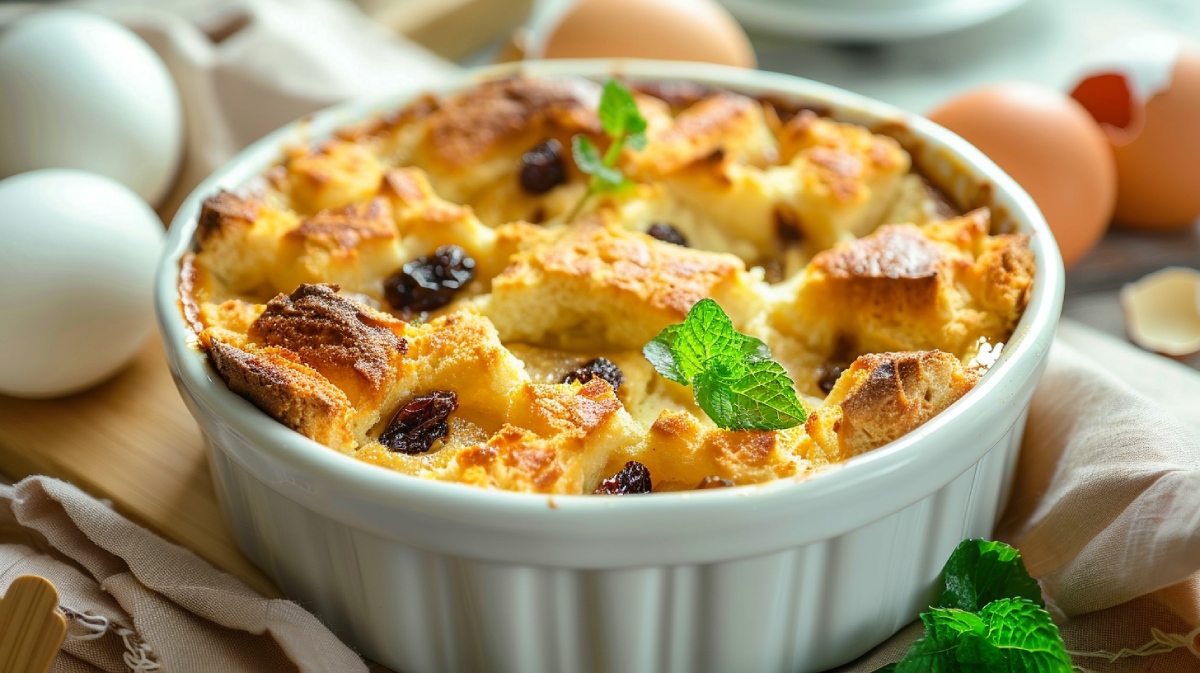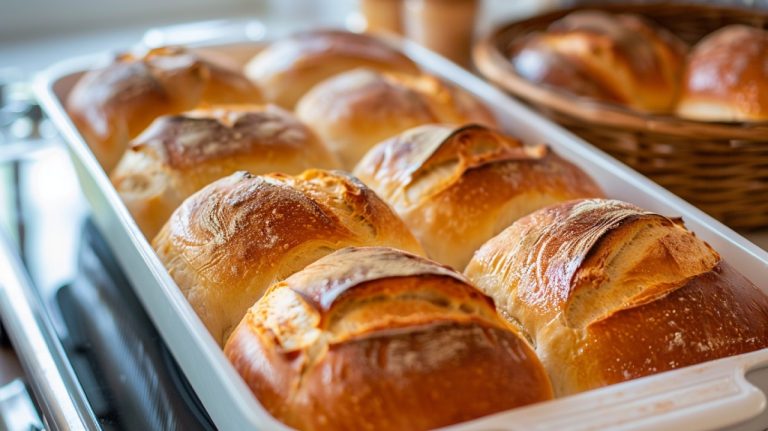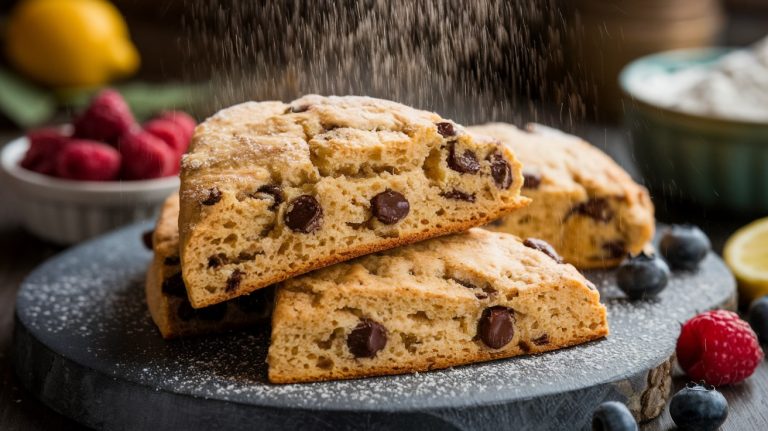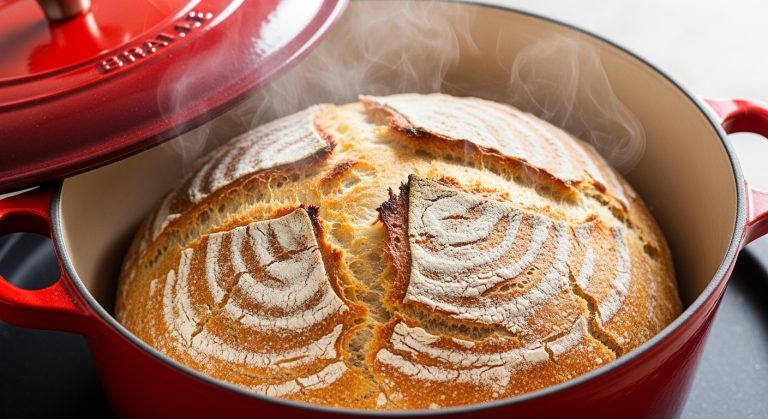Can You Make Bread Pudding With Sourdough Bread?
Yes, you can definitely make bread pudding with sourdough bread! This versatile dessert transforms stale sourdough into a mouthwatering treat, thanks to its tangy flavor that perfectly complements the creamy custard.
You’ll create a rich and satisfying dish by cubing the stale bread and soaking it in a mixture of milk, eggs, sugar, and vanilla. When baked, sourdough forms a golden brown exterior while maintaining a firmer texture, preventing mushiness.
You can even customize it with nuts, dried fruits, or chocolate for extra flavor. Would you like some unique variations or serving suggestions?
Key Takeaways
- Yes, sourdough bread is excellent for bread pudding, providing a rich, tangy flavor that complements the custard.
- The firmer texture of stale sourdough prevents mushiness, making it ideal for absorbing custard.
- Sourdough bread pudding can be customized with various add-ins like dried fruits, nuts, or chocolate.
- Bake sourdough bread pudding at 350°F for 45 minutes to 1 hour for a golden brown top.
Overview of Sourdough Bread Pudding
Sourdough bread pudding transforms stale bread into a deliciously rich dessert, where the tangy flavor of sourdough perfectly complements a creamy custard. This dish takes advantage of stale sourdough bread, soaking up the custard mixture made from eggs, whole milk, sugar, and vanilla. The result is a rich custard that balances beautifully with the unique sour notes of the bread, creating a dessert that’s both comforting and intriguing.
When baked in a suitable baking dish at 350°F for 45 minutes to an hour, the pudding develops a golden brown exterior while ensuring the inside is set and flavorful. The firmer texture of sourdough compared to softer sweet breads, like brioche, helps it maintain structure, preventing an overly mushy texture.
One of the best parts about sourdough bread pudding is its versatility. You can easily customize this dessert by adding your favorite ingredients, such as dried fruits, nuts, or even chocolate, making it a delightful canvas for your creativity. Whether you stick to the classic version or explore variations, sourdough bread pudding offers a satisfying and indulgent experience.
Essential Ingredients
To create a delightful sourdough bread pudding, you’ll need a handful of essential ingredients that come together to form a rich and flavorful dessert.
Start with stale sourdough bread, as its texture allows it to absorb the custard mixture beautifully without turning mushy. Aim for about 3 cups of cubed bread, but feel free to adjust based on your baking dish size.
Next, prepare the custard mixture, which is the heart of your sourdough bread pudding. You’ll need whole milk for that creamy consistency, eggs to provide structure, and sugar to add a touch of sweetness. Don’t forget the vanilla extract, which infuses your pudding with a warm, inviting flavor.
For an extra layer of taste, consider adding spices like cinnamon or nutmeg, or toss in some dried fruits like raisins to elevate your dessert even further.
Preparation Instructions
Start by tearing or cutting your stale sourdough bread into 1-inch cubes to kick off your bread pudding adventure. This step is essential, as it allows the bread to soak up the delicious custard mixture you’ll whip up next.
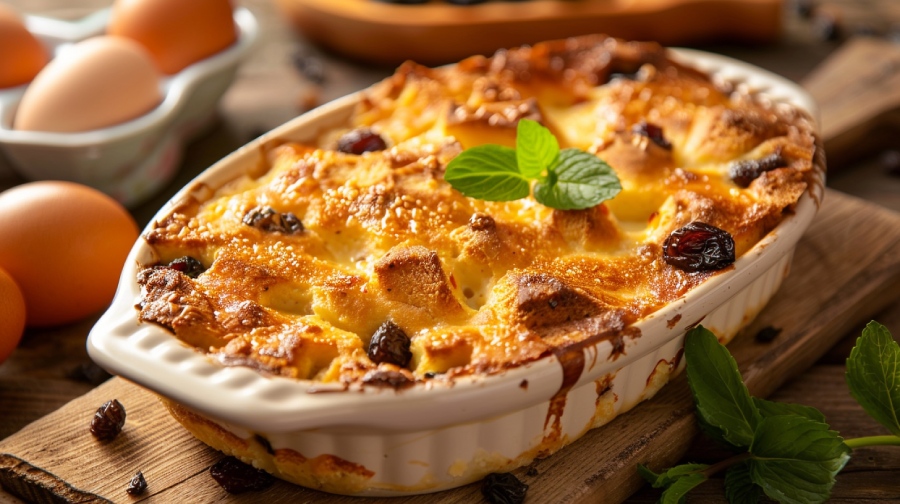
With your bread ready, whisk together the eggs, milk, and spices to create a creamy base that will transform your pudding into a delightful treat.
Bread Cubes Preparation
Cut or tear day-old sourdough bread into 1-inch cubes for perfect soaking and texture in your bread pudding. Using stale bread is key here; it’ll absorb the custard better than fresh bread, giving you that rich, flavorful result you crave. Aim for about 3 cups of sourdough bread cubes to keep a balanced ratio with your custard mixture.
If you’re starting with fresh sourdough, don’t worry! Leave it overnight to dry slightly or give it a light toast. This helps improve its ability to absorb the custard, ensuring your pudding is moist.
Consider experimenting with different types of sourdough bread to enhance your pudding’s flavor profile. Whole grain or seeded varieties add an interesting depth, complementing the sweetness of the custard beautifully.
The key is to achieve the ideal texture with those bread cubes as they soak up the custard, creating that deliciously gooey interior that makes bread pudding so irresistible. So, get ready to plunge into this delicious preparation step, and watch how your chosen sourdough transforms into a comforting dessert!
Custard Mixture Whisking
Whisk together the eggs, warm milk, vanilla extract, and brown sugar in a large bowl until the mixture is smooth and well combined, guaranteeing every ingredient melds perfectly for a deliciously rich custard. To enhance the flavor of your sourdough bread pudding, consider adding cinnamon to the custard mixture—just a teaspoon will do wonders.
Before whisking, gently heat the whole milk to prevent curdling when you add the eggs. Allow the milk to cool slightly to maintain a velvety texture. For an even richer custard, substitute some of the milk with heavy cream, adjusting the ratio accordingly.
Here’s a quick reference table for your custard mixture:
| Ingredient | Measurement | Purpose |
|---|---|---|
| Eggs | 9 large | Base of the custard |
| Whole Milk | 7 cups | Liquid richness |
| Brown Sugar | 1½ cups | Sweetness and flavor |
| Cinnamon | 1 teaspoon | Flavor enhancement |
Whisking thoroughly guarantees even flavor distribution, allowing every piece of bread to soak up that luscious custard mixture.
Baking Techniques
To achieve the perfect bread pudding, you need to start by preheating your oven to 350°F.
As you bake, keep an eye on the time and adjust it based on your dish’s depth—shallow dishes cook faster, while deeper ones may require a bit more time.
With these techniques, you’ll guarantee a deliciously creamy texture without burning the top.
Optimal Baking Temperature
Baking your sourdough bread pudding at 350°F (175°C) strikes the perfect balance, ensuring a creamy custard while achieving a beautifully browned top. This ideal baking temperature allows the custard to set gently without overcooking, giving you that delightful texture you crave.
When you use a shallow baking dish, the increased surface area promotes even baking, allowing your pudding to cook through more quickly than in a deeper dish. Typically, you’ll want to bake it for about 45 minutes to 1 hour, checking frequently for that golden brown top and a set custard. If you notice the top browning too fast, don’t hesitate to cover it loosely with foil; this will protect it from burning while the rest cooks perfectly.
Once your sourdough bread pudding is done, remember to allow it to rest for 10-15 minutes. This resting period enhances the flavors and improves the overall texture, making it even more enjoyable.
Baking Time Adjustments
When it comes to perfecting your sourdough bread pudding, adjusting the baking time can make all the difference in achieving that creamy custard consistency you desire. The typical baking time ranges from 45 minutes to 1 hour at 350°F, but this can vary based on the thickness of the custard and the size of your baking dish.
| Baking Dish Type | Recommended Baking Time |
|---|---|
| Shallow Baking Dishes | 45 minutes |
| Standard Dishes | 45 to 60 minutes |
| Deep Dishes | 60 to 75 minutes |
Using shallow baking dishes allows for faster cooking due to increased surface area. Conversely, deeper dishes may require an additional 15 minutes to guarantee even cooking. Keep an eye on your pudding as it bakes; if the top begins to brown too quickly, cover it loosely with aluminum foil.
To check for doneness, insert a knife into the center—if it comes out clean, your pudding is ready. Remember to adjust baking times based on your oven performance, as some ovens may cook faster or slower than the standard times.
Serving Suggestions
Serving warm bread pudding with a rich drizzle of caramel or chocolate sauce enhances its sweetness and elevates the overall flavor experience. When you prepare sourdough bread pudding, consider these serving suggestions to make it truly memorable:
- Add a scoop of vanilla ice cream: The creamy texture creates a delightful contrast with the warm pudding, making each bite irresistible.
- Top it with whipped cream: A dollop of whipped cream lightens the dish, adding an airy element that complements the richness.
- Garnish with fresh berries: Fresh berries not only add a pop of color but also provide a zesty brightness that balances the sweetness of the pudding.
- Serve in individual portions: Using ramekins for serving gives a charming touch to your presentation, making it easy for guests to enjoy their own delightful servings.
Finish off your presentation by dusting the pudding with powdered sugar for an elegant touch.
Flavor Customization
When it comes to flavor customization in sourdough bread pudding, the options are endless.
You can spice things up with warm notes of nutmeg or ginger while adding chocolate chips or dried fruits, which introduces delightful textures and sweetness.
Experimenting with different sugars and citrus zests will elevate your dish, making each bite a unique experience.
Spice and Sweetness Options
To elevate your bread pudding, infuse it with a warm blend of spices like cinnamon and nutmeg while balancing sweetness with brown sugar or dried fruits. These flavor enhancements transform your sourdough bread pudding into an irresistible dessert.
Here are some spice and sweetness options to reflect upon:
- Cinnamon: Add about 1 teaspoon to your custard mixture for warmth without overpowering the dish.
- Brown Sugar: Use 1½ cups to deepen the sweetness, or reduce by 50g if using sweeter breads.
- Vanilla Extract: Incorporate 1 tablespoon to elevate the sweetness and infuse a fragrant aroma.
- Dried Fruits or Chocolate Chips: Contemplate adding 1 cup of dried fruits like raisins or cranberries for natural sweetness that complements the tangy sourdough. Alternatively, mix in about ½ cup of chocolate chips for a deliciously rich flavor.
Add-ins for Texture
Enhancing the texture of your sourdough bread pudding with thoughtful add-ins elevates the dish and invites a delightful contrast in each bite.
Consider incorporating dried fruits like raisins, cranberries, or apricots; they provide bursts of sweetness and chewiness that complement the soft custard-soaked bread. Nuts, such as pecans or walnuts, add a crunchy contrast, creating a satisfying textural variation that keeps every forkful interesting.
If you’re craving richness, chocolate chips or chunks can introduce a melty quality, beautifully balancing the tangy notes of the sourdough. Fresh fruits like berries or bananas infuse moisture and a burst of freshness, lightening the overall richness of the custard.
Don’t forget about spices! Experimenting with nutmeg or ginger not only enhances your flavor profile but also adds a layer of complexity to the texture experience.
Storage and Reheating Tips
Storing and reheating your sourdough bread pudding properly can guarantee it retains its delicious flavor and texture for days to come. Here are some essential tips to help you manage those leftovers:
- Refrigeration: Store your freshly baked sourdough bread pudding in the refrigerator for up to 3-4 days. Make certain to cover it tightly to maintain its freshness and prevent it from drying out.
- Freezing: If you want to keep it longer, you can freeze the bread pudding for 2-3 months. Wrap it tightly in plastic wrap or aluminum foil, and then place it in an airtight container to lock in flavor.
- Thawing: Before you’re ready to enjoy your frozen bread pudding, thaw it overnight in the refrigerator. This step is vital for preserving its texture and flavor.
- Reheating: For reheating, skip the microwave! Instead, place the leftovers in the oven at 350°F for 15-20 minutes, covering them with aluminum foil. This method guarantees the pudding stays moist and delicious.
Variations to Try
After you’ve mastered the art of storing and reheating your sourdough bread pudding, it’s time to explore exciting variations that can elevate this classic dessert into something uniquely yours. You can transform your delicious bread pudding by using leftover sourdough bread and experimenting with different flavors.
Here are some variations to try:
| Sweet Variations | Savory Variations |
|---|---|
| Chocolate Sourdough Bread Pudding | Savory Sourdough Bread Pudding |
| Pumpkin Spice Variation | Nutty Crunch Option |
| Fruit-Enhanced Bread Pudding |
For a rich and indulgent treat, add chocolate chips or cocoa powder to your custard for a chocolate sourdough delight. If you’re in the mood for a seasonal twist, mix in pumpkin puree and spices for a pumpkin spice variation.
On the savory side, create a savory bread pudding by incorporating cheese, cooked sausage, and fresh herbs for a brunch hit. Don’t forget to sprinkle nuts on top for the nutty crunch option, or toss in dried and fresh fruits to enhance your bread pudding with sweetness and texture.
Frequently Asked Questions
What Not to Do With Sourdough?
Don’t store sourdough bread in the fridge; it’ll dry out. Avoid using fresh bread for soaking, and steer clear of moldy or smelly loaves. Balance moisture in recipes to keep your dish from becoming mushy.
Does Sourdough Bread Turn to Sugar Like Other Breads?
Like a secret agent, sourdough bread sneaks sugars into your system slowly. It does turn to sugar, but thanks to fermentation, it releases them gradually, preventing those sudden spikes other breads can cause.
What to Use Sourdough Bread For?
You can use sourdough bread in various dishes like bread pudding, croutons, or savory stuffing. Its firm texture and tangy flavor elevate your meals while repurposing leftovers helps reduce waste and adds creativity to your cooking.
What Can I Do With Stale Sourdough?
You can transform stale sourdough into delicious croutons, flavorful breadcrumbs, or even savory strata. Each option breathes new life into your leftovers, ensuring nothing goes to waste while creating tasty meals. Embrace your creativity!
Sourdough Bread Pudding: A Cozy Dessert That Turns Ordinary into Extraordinary
Ultimately, using sourdough bread for your pudding transforms humble ingredients into a warm embrace of flavors.
As the golden crust forms, it cradles the soft, custardy center, inviting you to indulge in its comforting sweetness.
So, gather your loved ones, serve them warm, and let their delightful aroma weave through your home, turning an ordinary day into a cherished memory.
With each bite, you’ll savor not just the dessert but the joy of togetherness it brings.

